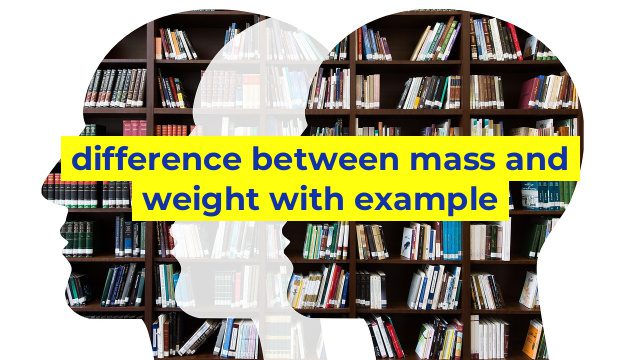Understanding the Difference between Mass and Weight
Have you ever wondered what the difference between mass and weight is? While many people use these terms interchangeably, they actually refer to distinct physical properties. Understanding the difference between mass and weight is crucial not only for academic pursuits, but also for practical purposes such as weight loss, exercise, and even space travel.
Mass and Weight: Definitions and Examples
In physics, mass refers to the amount of matter within an object, measured in units such as kilograms or grams. Mass is an intrinsic property, meaning that it does not depend on the object’s surroundings, location, or gravitational field. For example, a baseball has the same mass whether it is on Earth, the moon, or in space.
Weight, on the other hand, refers to the force exerted on an object by gravity, measured in units such as newtons or pounds. Weight is a relative property that varies depending on the object’s location and gravitational field. For example, a baseball weighs less on the moon than it does on Earth, because the gravitational force on the moon is weaker.
To illustrate further, imagine that you have a 1-kilogram bag of apples. Its mass is 1 kilogram, regardless of where it is placed. However, its weight varies depending on the planet or moon it is located on. On Earth, the bag of apples weighs approximately 9.8 newtons (or 2.2 pounds). On the moon, it would weigh only about 1.6 newtons (or 0.36 pounds), due to the weaker gravitational force.
Importance of Knowing the Difference
Understanding the difference between mass and weight is crucial in a wide range of areas, from science and engineering to everyday life. For example, it is essential in space travel, where the weight of objects and spacecraft can affect fuel consumption and trajectory. Knowing the mass of an object can also help calculate other physical properties such as density and volume.
Moreover, knowing the difference between mass and weight can be beneficial in health and fitness pursuits. While weight is often used as a measure of health and fitness, it can be misleading since it varies depending on factors such as muscle mass, hydration, and clothing. Mass, on the other hand, is a more reliable measure of body composition and can be determined through methods such as body fat analysis.
Conclusion
In summary, mass and weight are two distinct physical properties that are often used interchangeably. Mass refers to the amount of matter in an object, while weight refers to the force exerted on an object by gravity. Understanding the difference between mass and weight is important in a variety of settings, from scientific research to practical applications such as health and fitness. By knowing the difference, we can make more accurate calculations, measurements, and decisions.
Table difference between mass and weight with example
| Attribute | Mass | Weight |
|---|---|---|
| Definition | Mass is the amount of matter present in an object. | Weight is the force exerted on an object due to gravity. |
| Measurement Unit | Measured in kilograms or grams. | Measured in newtons. |
| Remains constant | Mass remains the same, regardless of the location of an object. | Weight varies based on the gravitational pull of the location. |
| Example | The mass of a 50-gram box will be the same on Earth or the Moon. | The weight of a 50-gram box will be less on the Moon due to the weaker gravitational pull. |


